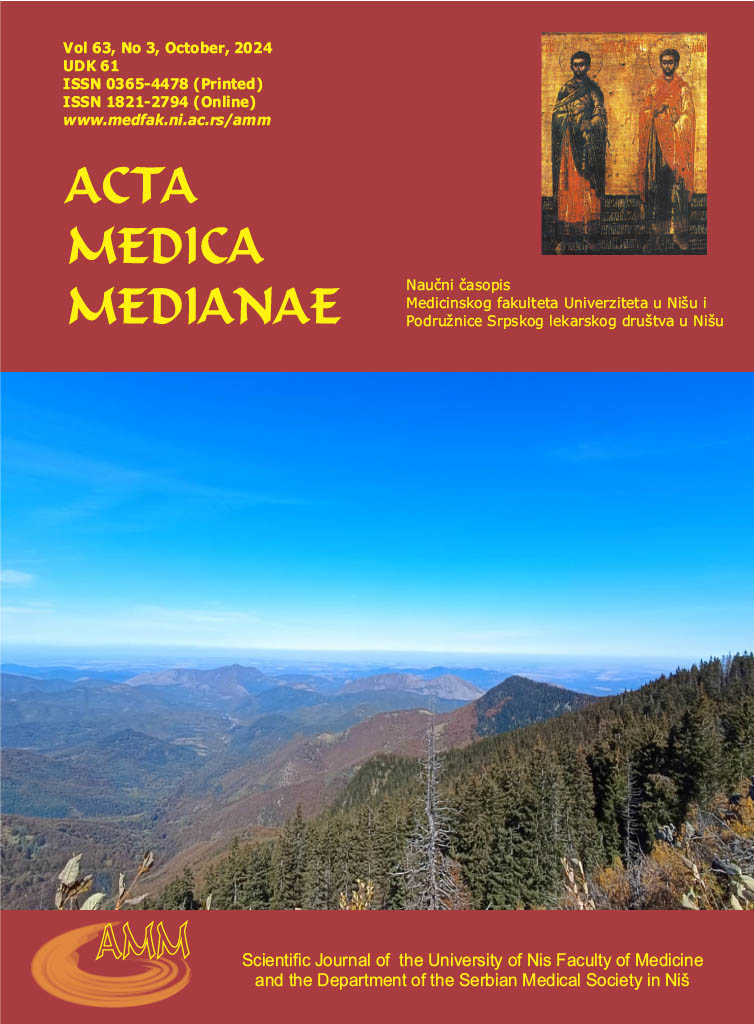DIMENZIJE LJUBAZNOSTI U POPULACIJI STUDENATA
Sažetak
Postupci pomaganja drugima manifestacija su personalne dimenzije zvane ljubaznost, koja je od posebnog značaja u medicini. Sposobnost medicinskih radnika da pokažu ljubaznost jedan je od faktora koji određuju budući tok lečenja bolesnika.
Primarni cilj istraživanja jeste utvrđivanje prisustva kategorije ljubaznosti u grupi studenata Medicinskog fakulteta i u grupi studenata drugih fakulteta Univerziteta u Nišu, kao i utvrđivanje postojanja razlika u kategorijama ljubaznosti između ovih dveju grupa studenata.
Onlajn upitnik je popunilo ukupno 230 ispitanika. Za procenu ljubaznosti korišćen je višedimenzionalni instrument „Skala ljubaznosti”. Podaci su predstavljeni kao srednje vrednosti rezultata za svaki aspekt ljubaznosti, te kao maksimalne i minimalne vrednosti. Poređenje dveju grupa izvršeno je Studentovim t-testom za dva velika nezavisna uzorka.
Rezultati su pokazali da među grupama ispitanika ne postoji razlika ni u jednoj dimenziji ljubaznosti. Rezultati su dali uvid u prirodu ljubaznosti, prepreke ispoljavanja ljubaznosti, kao i njen značaj i ukazali su na neophodnost razmišljanja o dimenziji ljubaznosti u radu sa studentima i u svakodnevnoj kliničkoj praksi.
Reference
Arnsten AFT, Shanafelt T. Physician distress and burnout: The neurobiological perspective. Mayo Clin Proc 2021;96:763-9. [CrossRef][PubMed]
Asch SM, Atkins D, Walling A. If kindness were a drug, the FDA would approve it. J Gen Intern Med 2021;263-4. [CrossRef][PubMed]
Bowlby J, editor. Attachment and loss: Vol. I: Attachment. 2nd ed. New York: Basic Books; 1969.
Buchanan KE, Bardi A. Acts of kindness and acts of novelty affect life satisfaction. J Soc Psychol 2010;150:235-7. [CrossRef][PubMed]
Canter D, Youngs D, Yaneva M. Towards a measure of kindness: An exploration of a neglected interpersonal trait. Personality and Individual Differences 2017;106:15-20. [CrossRef]
Decety J, Smith KE, Norman GJ, Halpern J. A social neuroscience perspective on clinical empathy. World Psychiatry 2014;13:233-7. [CrossRef][PubMed]
Eisenberger NI, Master SL, Inagaki TK, Taylor SE, Shirinyan D, Lieberman MD, et al. Attachment figures activate a safety signal-related neural region and reduce pain experience. Proc Natl Acad Sci USA 2011;108:11721-6. [CrossRef][PubMed]
Emmons RA, Crumpler CA. Gratitude as a human strength: Appraising the evidence. J Soc Clin Psychol 2000;19:56-69. [CrossRef]
Eslinger PJ, Anders S, Ballarini T, Boutros S, Krach S, Mayer AV, et al. The neuroscience of social feelings: mechanisms of adaptive social functioning. Neurosci Biobehav Rev 2021;128:592-620. [CrossRef][PubMed]
Frith C, Wolprit D, editors. The neuroscience of social interaction: Decoding, imitating, and influencing the actions of others. Oxford: Oxford University Press; 2004. [CrossRef]
Fryburg DA. Kindness isn't just about being nice: The value proposition of kindness as viewed through the lens of incivility in the healthcare workplace. Behav Sci (Basel) 2023;13:457. [CrossRef][PubMed]
Gleichgerrcht E, Decety J. Empathy in clinical practice: How individual dispositions, gender, and experience moderate empathic concern, burnout, and emotional distress in physicians. PLoS One 2013;8(4):e61526. [CrossRef][PubMed]
Hart R. Prosocial behaviors at work: Key concepts, measures, interventions, antecedents, and outcomes. Behav Sci 2024;14:78. [CrossRef][PubMed]
Klein M. Envy and gratitude and other works 1946-1963. London: Virago; 1988.
Lyubomirsky S, King L, Diener E. The benefits of frequent positive affect: does happiness lead to success? Psychol Bull 2005;131:803-55. [CrossRef][PubMed]
McCullough ME, Emmons RA, Tsang JA. The grateful disposition: A conceptual and empirical topography. J Pers Soc Psychol 2002;82:112-27. [CrossRef][PubMed]
Meyer-Lindenberg A, Domes G, Kirsch P, Heinrichs M. Oxytocin and vasopressin in the human brain: social neuropeptides for translational medicine. Nat Rev Neurosci 2011;12:524-38. [CrossRef][PubMed]
Oishi S, Schiller J, Gross EB. Felt understanding and misunderstanding affect the perception of pain, slant, and distance. Soc Psychol Pers Sci 2013;4:259-66. [CrossRef]
Peterson C, Ruch W, Beermann U, Park N, Seligman M. Strengths of character, orientations to happiness, and life satisfaction. J Posit Psychol. 2007;2:149-56. [CrossRef]
Porath CL, Foulk T, Erez A. How incivility hijacks performance: It robs cognitive resources, increases dysfunctional behavior, and infects team dynamics and functioning. Organ Dyn 2015;44:258-65. [CrossRef]
Porges SW. Social engagement and attachment: a phylogenetic perspective. Ann N Y Acad Sci 2003;1008:31-47. [CrossRef][PubMed]
Porges SW. The polyvagal theory: phylogenetic substrates of a social nervous system. Int J Psychophysiol 2001;42:123-46. [CrossRef][PubMed]
Rowland L, Curry OS. A range of kindness activities boost happiness. J Soc Psychol 2018;159:340-3. [CrossRef][PubMed]
Shapiro J, Youm J, Kheriaty A, Pham T, Chen Y, Clayma R. The human kindness curriculum: An innovative preclinical initiative to highlight kindness and empathy in medicine. Educ Health (Abingdon) 2019;32:53-61. [CrossRef][PubMed]
Tang W, Wu D, Yang F, Wang C, Gong W, Gray K, et al. How kindness can be contagious in healthcare. Nat Med 2021;27:1142-4. [CrossRef][PubMed]
Watkins P, Woodward K, Stone T, Kolts R. Gratitude and happiness: Development of a measure of gratitude, and relationships with subjective well-being. Soc Behav Pers 2003;31:431-51. [CrossRef]
Youngs DE, Yaneva MA, Canter DV. Development of a measure of kindness. Curr Psychol 2023;42:5428-40. [CrossRef]

